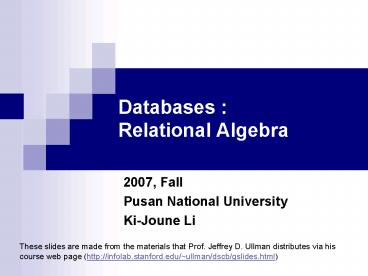Databases : Relational Algebra - PowerPoint PPT Presentation
1 / 16
Title:
Databases : Relational Algebra
Description:
Sue's. Maple St. Joe's. addr. name. BarInfo = Sells JOIN Sells.bar = Bars.name Bars ... Sue's. Maple St. Joe's. addr. Bar. BarInfo = Sells Bars. BarInfo (bar, ... – PowerPoint PPT presentation
Number of Views:41
Avg rating:3.0/5.0
Title: Databases : Relational Algebra
1
Databases Relational Algebra
- 2007, Fall
- Pusan National University
- Ki-Joune Li
These slides are made from the materials that
Prof. Jeffrey D. Ullman distributes via his
course web page (http//infolab.stanford.edu/ullm
an/dscb/gslides.html)
2
What is an Algebra
- Mathematical system consisting of
- Operands variables or values from which new
values can be constructed. - Operators symbols denoting procedures that
construct new values from given values.
3
What is Relational Algebra?
- An algebra
- Operands relations or variables that represent
relations. - Operators common operations that we need to do
with relations in a database. - Relational Algebra a Theoretical basis of query
language.
4
Core Relational Algebra
- Set Operators
- Union, intersection, and difference.
- Selection picking certain rows.
- Projection picking certain columns.
- Products and joins compositions of relations.
- Renaming of relations and attributes.
5
Selection
- R1 SELECTC (R)
- C is a condition (as in if statements) that
refers to attributes of R. - R1 is all those tuples of R that satisfy C.
- Denoted as sC (R)
6
Example
Relation Sells
JoeMenu SELECTbarJoes(Sells)
7
Projection
- R1 PROJL (R)
- L a list of attributes from the schema of R.
- R1 is constructed by looking at each tuple of R,
extracting the attributes on list L, in the order
specified, and creating from those components a
tuple for R1. - Eliminate duplicate tuples, if any.
- Denoted pL (R)
8
Example
Relation Sells
Prices PROJbeer,price(Sells)
9
Product (also Cartesian Product)
- R3 R1 x R2
- Pair each tuple t1 of R1 with each tuple t2 of
R2. - Concatenation (t1 t2) is a tuple of R3.
- Schema of R3 the attributes of R1 and R2, in
order. - But beware attribute A of the same name in R1 and
R2 use R1.A and R2.A.
10
Example R1 x R2
R1(A, B)
R3(A, R1.B, R2.B, C)
R2(B, C)
11
Theta-Join
- R3 R1 JOINC R2
- Take the product R1 X R2.
- Then apply SELECTC to the result.
- Also denoted R1 C R2
- As for SELECT, C can be any boolean-valued
condition. - Historic versions of this operator allowed only A
theta B, where theta was , lt, etc. hence the
name theta-join.
12
Example
Sells (bar, beer, price)
Bars (name,addr)
BarInfo Sells JOIN Sells.bar Bars.name Bars
BarInfo (bar, beer, price, name, addr)
13
Cartesian Product and Theta Join
- R1 C R2 ? R1 X R2
- R1 C R2 sC (R1 X R2)
s
X
R1
R2
14
Natural Join
- A frequent type of join connects two relations
by - Equating attributes of the same name, and
- Projecting out one copy of each pair of equated
attributes. - Called natural join.
- Denoted
- R3 R1 JOIN R2 or
- R3 R1 R2
- R1 JOIN R2 Select R1.A R2.A (R1 X R2)
15
Example
Sells (bar, beer, price)
Bars (name,addr)
BarInfo Sells Bars
BarInfo (bar, beer, price, name, addr)
16
Renaming
- The RENAME operator gives a new schema to a
relation. - R1 RENAMER1(A1,,An)(R2) makes R1 be a
relation with attributes A1,,An and the same
tuples as R2. - Simplified notation R1(A1,,An) R2
orrR1(A1,,An)(R2)

